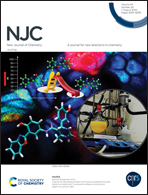Cadmium metavanadate mixed oxide nanorods for the chemiresistive detection of methane molecules†
Abstract
Mixed transition metal oxides (MTMOs) have recently been explored as building blocks for gas sensing applications due to their enhanced sensing characteristics. Here, we demonstrate the application of a co-sputtered V2O5–CdO thin film as a novel chemiresistive sensor for the detection of methane (CH4) gas. From X-ray diffraction (XRD) studies, the mixed phase was identified as polycrystalline cadmium metavanadate (CdV2O6), and from X-ray photoelectron spectroscopy (XPS) studies, the clear existence of V5+ and Cd2+, corresponding to V2O5–CdO, was observed. The obtained mixed phase featured fused nanorod-like structure with ∼450 nm thickness. By monitoring the sequential sensing characteristics over various temperature (RT-150 °C) and concentration (25–500 ppm) range, the optimum operating temperature (100 °C) was identified. The polycrystalline V2O5–CdO sensor exhibited a response of ∼1.72% towards 25 ppm CH4 at 100 °C. The use of evenly co-sputtered semiconductive (Cd2+ and V5+) nanorods will provide advanced routes towards the development of various devices based on MTMOs.



 Please wait while we load your content...
Please wait while we load your content...